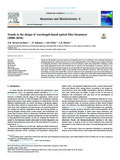Mostrar el registro sencillo del ítem
Trends in the design of wavelength-based optical fibre biosensors (2008–2018)
| dc.creator | Socorro Leránoz, Abián Bentor | es_ES |
| dc.creator | Santano, Desiree | es_ES |
| dc.creator | Del Villar, Ignacio | es_ES |
| dc.creator | Matías Maestro, Ignacio | es_ES |
| dc.date.accessioned | 2020-02-18T10:15:49Z | |
| dc.date.available | 2020-02-18T10:15:49Z | |
| dc.date.issued | 2019 | |
| dc.identifier.issn | 2590-1370 | |
| dc.identifier.uri | https://hdl.handle.net/2454/36252 | |
| dc.description.abstract | During the last decades, both governments and companies have been committed to the continuous checking of biological parameters, which can prevent extra costs to administrations. A very efficient way to address this issue is by designing biosensors. This contribution reviews the advances made using optical fibre technology, which have lately agglutinated much of the scientific interest related to the development of biosensors. However, the wide number of publications describing the use of optical fibre for detecting biomarkers has probably blurred the main goal: obtaining portable, simple, easy-to-handle and cost-effective biosensors. With this purpose, this contribution presents some optical fibre structures which have been analysed in terms of several optical parameters of interest from a photonics point of view: sensitivity, quality factor, full width at half minimum, limit of detection and figure of merit. This has made it possible to classify the most advanced optical fibre sensing techniques and, hence, their suitability when developing biosensing applications. | en |
| dc.description.sponsorship | This work was supported by the Regional Government of Navarra, Spain (projects with references 72/2015 and PC021-022) and by the Agencia Estatal de Investigación (Spanish National Research Agency) through the project with reference TEC2016-78047-R. | en |
| dc.format.extent | 20 p. | |
| dc.format.mimetype | application/pdf | en |
| dc.language.iso | eng | en |
| dc.publisher | Elsevier | en |
| dc.relation.ispartof | Biosensors and Bioelectronics: X, 1 (2019), 100015 | en |
| dc.rights | © 2019 The Author(s). Published by Elsevier B.V. This is an open access article under the CC BY license. | en |
| dc.rights.uri | http://creativecommons.org/licenses/by/4.0/ | |
| dc.subject | Optical fibre | en |
| dc.subject | Interferometry | en |
| dc.subject | Fabry–Pérot | en |
| dc.subject | Fibre Bragg gratings | en |
| dc.subject | Long-period fibre Bragg gratings | en |
| dc.subject | Surface plasmon resonance | en |
| dc.subject | Localized surface plasmon resonance | en |
| dc.subject | Lossy mode resonance | en |
| dc.title | Trends in the design of wavelength-based optical fibre biosensors (2008–2018) | en |
| dc.type | info:eu-repo/semantics/article | en |
| dc.type | Artículo / Artikulua | es |
| dc.contributor.department | Institute of Smart Cities - ISC | es_ES |
| dc.contributor.department | Ingeniería Eléctrica, Electrónica y de Comunicación | es_ES |
| dc.contributor.department | Ingeniaritza Elektrikoa, Elektronikoa eta Telekomunikazio Ingeniaritza | eu |
| dc.rights.accessRights | info:eu-repo/semantics/openAccess | en |
| dc.rights.accessRights | Acceso abierto / Sarbide irekia | es |
| dc.identifier.doi | 10.1016/j.biosx.2019.100015 | |
| dc.relation.projectID | info:eu-repo/grantAgreement/ES/1PE/TEC2016-78047-R | en |
| dc.relation.publisherversion | https://doi.org/10.1016/j.biosx.2019.100015 | |
| dc.type.version | info:eu-repo/semantics/publishedVersion | en |
| dc.type.version | Versión publicada / Argitaratu den bertsioa | es |
| dc.contributor.funder | Gobierno de Navarra / Nafarroako Gobernua | es |



